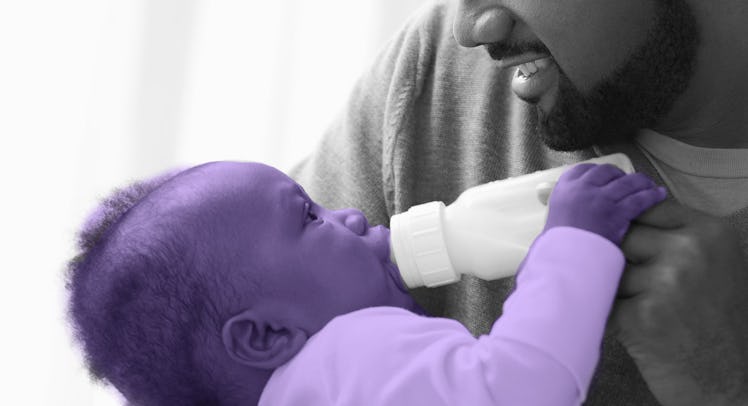How to Bottle Feed a Baby
Families who can’t breastfeed often feel a lot of guilt, but they shouldn’t. The most important part is that the baby gets fed, not how.

Breastfeeding is often touted as superior to bottle feeding and, nutritionally speaking, it may be. But for some families, due to allergies, illness, adoption, or simply the failure to latch, breastfeeding simply isn’t an option. Fortunately, bottle feeding, which requires a few more steps but hurts a lot less, works fine. It’s nothing to feel weird about (there are so many other things to feel weird about).
“Breastfeeding is extremely important, but it’s also extremely difficult. If it doesn’t work, that doesn’t mean that somebody has done something wrong or failed in any way,” says Elizabeth Murray, M.D., a pediatric emergency physician and spokesperson for the American Academy of Pediatrics. “It just is what it is. Luckily we live in a society where we have other options available to feed our children.”
Pumping breastmilk and using a bottle can help babies who have difficulty latching or sucking. The formula can be matched to babies with food allergies; in both cases, bottle feeding is the healthier choice for the family.
The bottle shape has less to do with how a baby feeds than the nipple hole size, the position of the bottle, and the position of the baby. Nipple holes are sized differently because babies feed differently; although the difference in sizes can be imperceptible, they are real. Too large and a baby may gag as they feed; too small and the baby may grow frustrated.
The bottle should be inverted as much as possible. The nipple should be filled with formula so the baby doesn’t suck in air; sometimes burping can send up the formula (and nutrition) that kid worked hard to get, particularly if they have feeding problems.
But while the bottle is inverted, the baby should be positioned as upright as possible; bottle feeding a baby flat on their back can increase their chances of getting ear infections. Ear infections don’t sound like a big deal, but they have the power to make entire families miserable.
Formula can’t replicate everything that breastmilk can deliver, but it can be matched to specific allergy or nutritional needs. Consulting with a pediatrician is the best way to find a match. Preparing formula is easy; just follow the directions on the packaging, and never, ever deviate. Babies don’t need extra water on hot days. They just need formula. In fact, diluting the formula can lead to seizures and other nasty side effects.
How to Bottle Feed a Baby
- Keep the baby as upright as possible and bottle as inverted as possible.
- Make sure they’re awake and don’t fall for the suck reflex.
- Take all safety precautions! Clear the bedding and set a timer to avoid falling asleep in dangerous situations.
- Don’t mess with the formula, and don’t heat in the microwave.
It isn’t necessary to use fancy bottled water to mix formula; tap water will do. Running hot water from the tap can increase the concentration of unwanted minerals from the pipes or water heater, so use cool tap water. If the bottle needs to be warmed up, it should be placed in a bowl of hot water to warm. Bottles should never be heated in the microwave.
Bottle feeding, in particular, allows fathers to bond with their baby and give their wives a break. It’s a treat to hold a brand new human, look in their eyes and whisper NWA’s sick rhymes as they bottle feed, even in the middle of the night. Nighttime feeding can have its own pitfalls, though.
Sleep safety can become an issue. Falling asleep with a baby seems very sweet, but it is extremely dangerous. Removing soft bedding before bringing the baby into bed to feed can help mitigate the risk, but can be disruptive to a sleeping partner. It’s much simpler to set an alarm.
“Just because you’re bottle feeding doesn’t mean you aren’t going to be exhausted as a parent,” warns Murray. “I always recommend that someone set a timer when they’re feeding at night. Exhausted parents can still fall asleep if they’re sitting in a comfortable chair, or sitting in their bed holding a baby, just like with breastfeeding.”
Sleeping babies also have a suck reflex, and so even if the kid falls asleep, pulling the bottle out will trigger those little lips to search for the nipple. It looks like the baby is still hungry, but they aren’t. If they stop trying to suck and stay asleep, they’ve had enough. If they wake up looking for that bottle, they haven’t.
Knowing the amount that a baby will consume in a single feeding helps with recognizing the suck reflex, but that amount also changes as the baby grows, sometimes drastically. Parents can find typical feeding volumes online, but it’s no substitution for a good consultation with a pediatrician and diligent observation of the baby’s behavior.